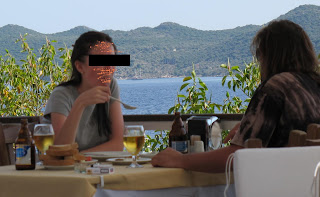Any traveller who has ever relied on a Lonely Planet (or any guidebook for that matter) knows the pain of searching out something labeled in the book as a "gem," only to arrive and find it closed, destroyed, or just plain disappointing. My last day in Kharkiv I set out on a mission to find "the stained-glass portraits of Yuri Gagarin [the first man in space] above the stairs to the platforms at the pr Gagarina station." Sounds pretty sweet, right? I was expecting something like this, which I had already seen in another station:
Or even as cool as this - the Creator Art Nouveau style, in a cathedral in Cracow:
Being spoiled by such beautiful "stained-glass portraits," I was sure this one was going to be pretty damn good. Who doesn't love Gagarin? Daniel and I were staying with Marina, a great woman we met on couchsurfing, and I noticed on her wall a printout of Gagarin. "I love him!" she gushed when I asked her about it. So I inquired about the stained-glass portrait. Certainly she must know about it! But she didn't, and we set off to have a look.
We arrived at Prospekt Gagarina metro station, and we couldn't find a thing. We were teased just by his name on the station wall, and these stars decorating the walls
Marina called a few friends but no one knew about it. We didn't have the guidebook on us, and I couldn't' remember exactly where it said the portrait was located. We asked a security guide. "Nu....mojet byt est' takoj.. no ya ne znayo gde eta nahoditsya..." He had no idea, and wasn't even prepared to tell us with a remote degree of confidence if it did or didn't exist.
Marina got an idea and brought me to a nearby children's store. Here a somewhat awkward statue of Gagarin was walking down the stairs in his spacesuit.
Call me naive, but I have faith in the Lonely Planet. I insisted that this wasn't what it was talking about. Another phone call to a friend of Marina. No one knew what I was on about. As we were closeby, Marina brought me to an old factory with murals painted on the walls by various artists. One was Gagarin, waving and smiling and he was being shot up into space. Also cool, but I am stubborn, and really wanted to see that "stained-glass portrait."
I convinced Marina to take one more try in the metro. This time, walking down the stairs to the platform (yes, those were the guidebooks original instructions, but we didn't have the guidebook on us), we looked up, and there we saw it. That is we thought we saw it; you need to squint a bit and use your imagination. By using the flash, you can actually see more in the picture than you can at the station:
Here's the other side (he's flying, if you can't tell):
I was pretty excited and decided to go tell the security guard that the whole time the stained-glass (stained with dirt, I suppose) was staring us in the face. He looked at us as if we were something Gagarin had picked up in space and didn't even ask where it was. Marina told me, "It is strange in Ukraine to tell him that we found it." This much I had gathered.
On my overnight train back home that night, I sat across from an older man who wanted to chat about the old days, kak eta byla... I told him my story about the search for Gagarin. His eyes lit up, as he is an amateur astronomer himself. He pointed out a number of stars through the window of our train, and over the next hour or so, slowly folded out his theories on extraterrestrial life. During Soviet times, stories of alien sightings and abductions were suppressed, he told me, but now there are plenty of books in Russian and he reads them non-stop. But he can't find a good book in Russian on black holes and black matter, even in Moscow.
He is retired from the army, but his pension is so little that he frequently rides the overnight train to Kharkiv to pick up new supplies to sell in the bazaar in Sevastopol. "Do you know how much the pension is for a German soldier? Do you know how much! More than a thousand Euros a month, and we get peanuts. And we won the war! They were fascists, fascists! Ponimaesh, da? Nazis!" The next morning he spoke nothing of pensions or extraterrestrials, but gave me some of the treats he had picked up in Kharkiv. Moscow chocolate-coated nuts and biscuits. When we arrived in Simferopol, he gathered his bundles and rushed to catch his two-hour train to Sevastopol. If you are under the mis-impression that Russian and Ukrainians are unfriendly, cold people, ride around on trains for a few days.
After all this, I finally decided on my next cross-stitch pattern (yes, I've picked up cross-stitch, a subject for another post), which I created on Photoshop from the photo on Marina's wall:




















































